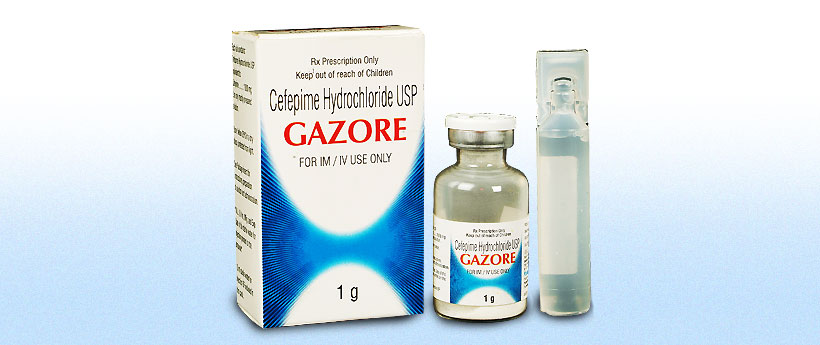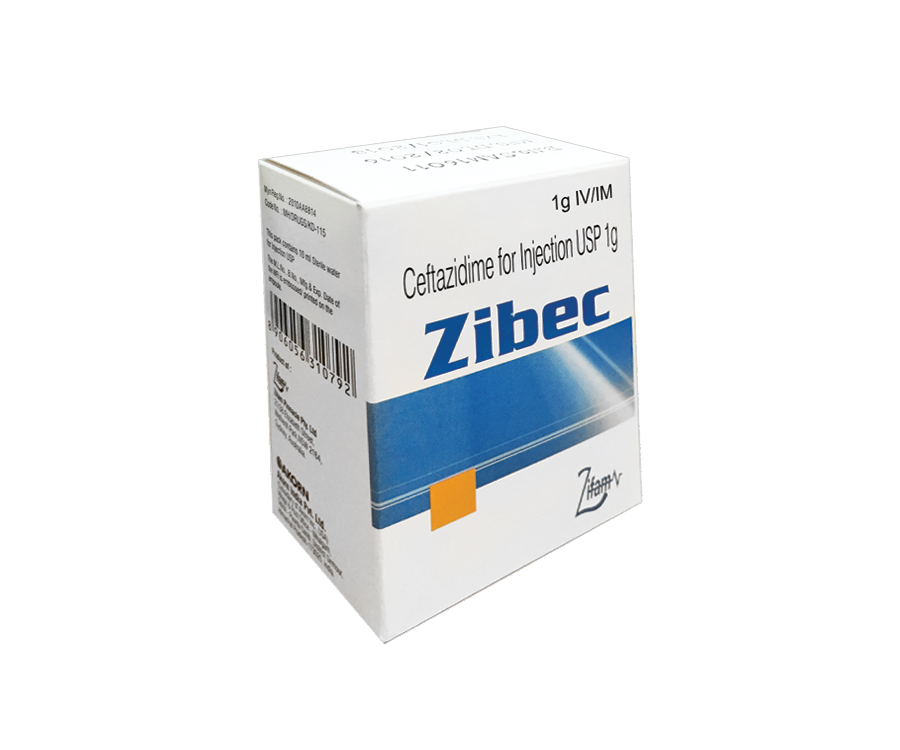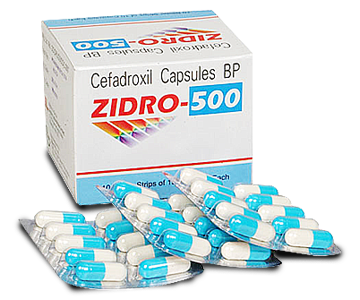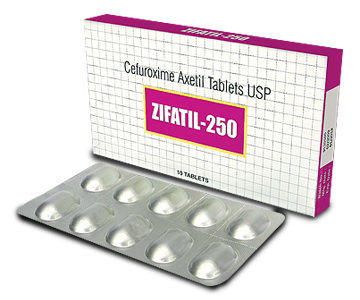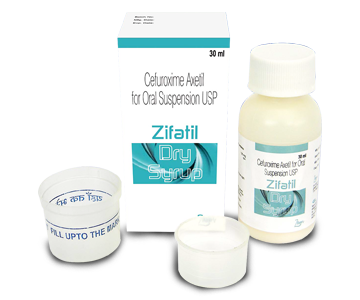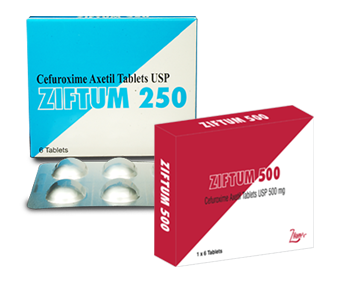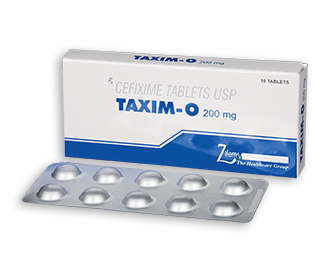Gazore 1g
- ENG
- မြန်မာ
COMPOSITION
GAZORE: (Cefipime hydrochloride USP) for injection is supplied for intramuscular or intravenous administration in strengths equivalent to 1 g of cefepime.
Description
GAZORE is a semi-synthetic, broad spectrum, fourth-generation cephalosporin antibiotic for parenteral administration. It has been shown to be more effective than other third-generation cephalsporins against several gram-negative isolates with better gram-positive coverage, good antipseudomonal activity and good beta-lactamase stability. In addition, the drug has been shown to inhibit various Enterobacteriaceae resistant to cefotaxime and ceftazidime.
INDICATIONS AND USAGE:
GAZORE is indicated in the treatment of the following infections:
- Pneumonia (moderate to severe)
- Empiric Therapy for Febrile Neutropenic Patients
- Uncomplicated and Complicated Urinary Tract Infections (including pyelonephritis)
- Uncomplicated Skin and Skin Structure Infections
- Complicated Intra-abdominal Infections (used in combination with metronidazole).
Culture and susceptibility testing should be performed where appropriate to determine the susceptibility of the causative microorganism (s) to cefepime.
Pediatric Use
The safety and effectiveness of GAZORE has been established in the age groups 2 months up to 16 years. Safety and effectiveness in pediatric patients below the age of 2 months have not been established.
CONTRAINDICATIONS
GAZORE is contraindicated in patients who have shown immediate hypersensitivity reactions to cefepime or the cephalosporin class of antibiotics, penicillin or other beta-lactam antibiotics.
Drug Interactions:
Renal function should be monitored carefully if high doses of aminoglycosides are to be administered with GAZORE because of the increased potiential of nephrotoxicity and ototoxicity of aminoglycoside antibiotics.
Nephrotoxicity has been reported following concomitant administration of other cephalosporins with potent diuretics such as furosemide.
Drug Interactions:
The administration of cefepime may result in false positive reaction for glucose in the urine when using Clinitest tablets. It is recommended that glucose tests based on enzymatic glucose oxidase reactions (such as Clinistix or Tes-Tape) be used.
Usage in Pregnancy and Lactation
Pregnancy Categoy B
No adequate and well controlled studies of cefepime use in pregnant women. Drug should be used during pregnancy only if clearly needed.
Nursing Mothers
GAZORE is excreted in human breast milk in very low concentrations (0.5µg/mL). Caution should be exercised when cefepime is administered to nursing women.
ADVERSE REACTIONS
In clinical trials using multiple doses of cefepime, 4137 patients were treated with the recommended dosages of cefepime (500mg to 2g IV q 12h).
OVERDOSAGE
Patients who receive an overdose should be carefully observed and given supportive treatment. In the presence of renal insufficiency, hemodialysis, not peritoneal dialysis is recommended to aid in the removal of cefepime from the body.
Symptoms of overdose include encephalopathy (disturbance of consciousness including confusion, hallucinations, stupor, and coma), myoclonus seizures and neuromuscular excitability
DOSAGE AND ADMINISTRATION
The recommended adult and pediatric dosages and routes of administration are outlined in the following table . GAZORE should be administered intravenously over approximately 30 minutes.
Recommended Dosage Schedule for GAZORE
| Site and Type of Infection | Dose | Frequency | Duration Days |
| Adults | |||
| Moderate to Severe Pneumonia | 1-2 g IV | q 12 h | 10 |
| Empiric therapy to Febrile Neutropenic patients | 2 g IV | q 8h | 7* |
| Mild to Moderate Uncomplicated or Complicated Urinary Tract Infections | 0.5-1g IV/IM | q12h | 7-10 |
| Severe Uncomplicated or Complicated Urinary Tract Infections, including pyeionephritis | 2g IV | q12h | 10 |
| Moderate to Severe Uncomplicated Skin and Skin Structure Infections | 2g IV | q12h | 10 |
| Complicated intra-abdominal infections(used in combination with metronidazole) | 2g IV | q12h | 7-10 |
| Pediatric Patients (2 months up to 16 years)The maximum dose for pediatric patients should not exceed the recommended adult dose. The usual recommended dosage in pediatric patients is 50mg/kg/dose, administered q 12 h (q8h for Febrile Neutropenic patients), for durations as given above. | |||
‘or until resolution of neutropenia. In patients whose fever resolves but who remain neutropenic for more than 7 days, the need for continued antimicrobial therapy should be re-evaluated frequently.
Impaired Hepatic Function – No adjustment is necessary for patients with impaired hepatic function.
Imparied Renal Function – In patients with impaired renal function (creatinine clearance £60 mL/min), the dose of GAZORE should be adjusted to compensate for the slower rate of renal elimination. The recommended maintenance doses of GAZORE in patients with renal insufficiency are presented in followinTable .
Recommended Maintenance Schedule in Adult Patients with Renal Impairment Relative to Normal Recommended Dosing Schedule.
| Creatinine Clearance (mL/min) | Recommended Maintenance Schedule | |||
| >60 normal recommended dosing schedule | 500mg q 12 h | 1g q 12 h | 2g q 12h | 2g q8h |
| 30-60 | 500mg q24h | 1g q24h | 2g q24h | 2g q12h |
| 11-29 | 500mg q24h | 500mg q24h | 1g q24h | 2 g q24h |
| <11 | 250mg q24h | 250mg q24h | 500mg q24h | 1g q24h |
Administration:
For intravenous infusion: constitute the 1g vial and add an appropriate quantity of the resulting solution to an IV container with one of the compatible IV fluids.
THE RESULTING SOLUTION SHOULD BE ADMINISTERED OVER APPROXIMATELY 30 MINUTES.
Intramuscular Administration: For IM administration GAZORE should be constituted with one of the following diluents. Sterile Water for injection 0.9% Sodium Chloride, 5% Dextrose Injection, 0.5% or 1.0%. Lidocaine Hydrochloride or Sterile Bacteriostatic Water for injection. Preparation of GAZORE solution is summarized in following Table
Preparation of Solutions of GAZORE
| Single Dose Vials for Intravenous/Intramuscular Administration | Amount of Diluent to be added (mL) | Approximate Avilable Volume (mL) | Approximate Cefepime (mg/mL) |
| GAZORE vial content | |||
| 1g (IV) | 10.0 | 11.3 | 100 |
| 1g (IM) | 2.4 | 3.6 | 290 |
.






